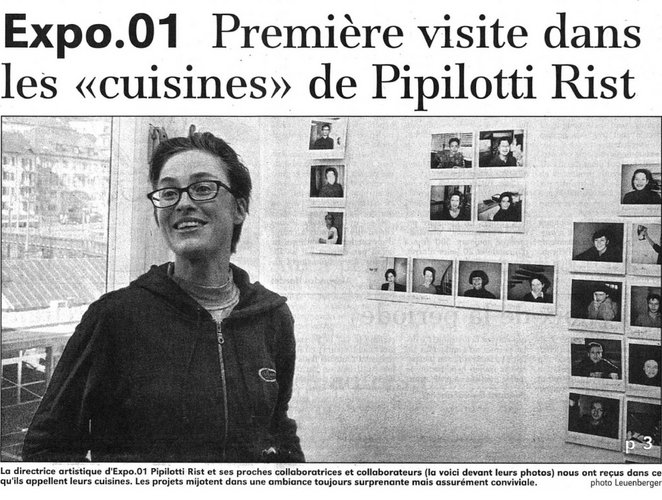When Pipilotti Rist took over the artistic management of the Expo, she wanted to create an overall piece of art. Contents and style of the exhibition had to comply with a uniform design concept from the first draft down to the finest details of the trashcans. According to the artist, “demands must be exacting in order to achieve anything at all”.
It remains disputed how much has actually been achieved. Some observers and participants considered Pipilotti Rist’s resignation in December 1998 as a sign of failure. They claimed that when it came down to brass tacks – as regards, for example, means of transport or restaurants – the artistic concept was simply not suitable and had to make way for functional design. Even within the creative team around Pipilotti Rist, working in the so-called Cuisine, some members firmly believed that the wider public – business, politics and the media – were not prepared or able to understand the coherent exhibition scenario and models produced by the creative minds. The unique model visions of the five Arteplages, presented in early 1998, leave a lasting impression. Paulo Ugolini and the architects, Marco Köppel and Carlos Martinez, were deeply involved in their design. The visionary models are associated with polarizing expressions from the think lab and the special themes for each Arteplage. Pipilotti Rist presented these visions during a media conference in early 1998 and publicly praised them in her Beresina Song (Song about a selfsacrifice of swiss soldiers – dictionnaire historique de la Suisse, Berne 2002).
Typically, a public presentation of additional architectural models in December 1998, relaxed the tension between artists and realists. The realists prevented Pipilotti Rist from presenting her opulent but obviously unrealizable models to the public during the ongoing international architecture competition. Pipilotti Rist took this decision as a slight which, no doubt, was one of the reasons for the popular artist’s resignation as head of the Direction Artistique. Looking back at the actual development of Expo and its architecture, the prospect of Pipilotti Rist’s think lab failing can only be one of many aspects. It is quite remarkable that during this dispute about models phase, the most important elements of the Expo architecture were created and, in some cases, even underwent further development. The team of artists not only inspired people, for example Jean Nouvel. Pipilotti Rist and others clearly also encouraged and urged him not to follow the competition propositions but to adhere to his complete architectural work of art for Morat, which he had in mind. The decentralized and yet thematic and formal entity of the Morat Arteplage, with the Monolith as architectural focus, thus fully complied with Pipilotti Rist’s basic artistic concept. Nouvel took up the association patterns and the special themes originating from the Cuisine, and he developed them further.
The Instant and Eternity concept was applied in great detail on the entire Arteplage and followed closely the “cuisine’s” multi-faceted and imaginative world of association. Hence, there was a remarkable continuity in the Expo’s development despite the change of management. There is an interesting footnote to the story: to a certain extent, architecture took over the integrating function of art.
This type of continuity is evident elsewhere, too, for example in the Cloud of Yverdon. Many visitors held steadfastly to the belief that the Cloud’s esprit symbolized the ideal and typical spirit of Expo. This esprit, or spirit, originated from the think lab under the management of the first artistic director; it turned into a vision during the presentation of the models in spring 1998, and it rekindled again in the poetic copy of the association patterns of the Arteplages. Take Yverdon, for example: “How much roughage do you digest daily? Have you ever seen the Man on the Moon, Mr. Nicollier? – No, but I have seen the earth from outside; in space. And is Switzerland an island? – If you have a clear view to the Mediterranean, it is; if you cannot see any sea or ocean, I would say Switzerland is no island. The wise woman smiles and is silent. A peach shines lecherously on the tree.” (taken from the publivation Masterplan 1998 / Yverdon).
As regards the Cloud, the artistic specifications, as understood by the Cuisine, were unsuitable and impossible to implement. Several teams of architects, scenographers and engineers were needed to cast off the old thoughts and to turn as much of the original idea as possible into practice. These are the two remarkable paradoxical concepts in the development of Expo and its architecture: the think lab was completely unsuitable and yet, at the same time, absolutely indispensable for their realization; its characters were diametrically opposed and yet closely related.
Lukas Schmutz, 2003, taken from the publication Architecture.Expo.02




